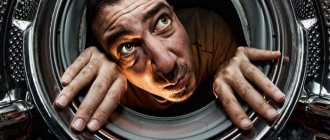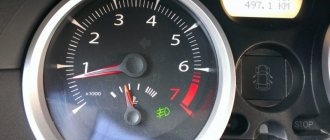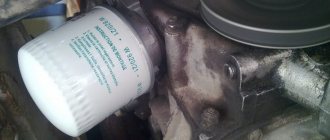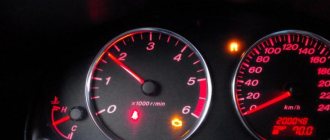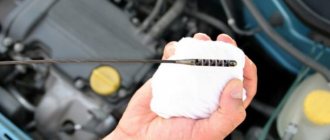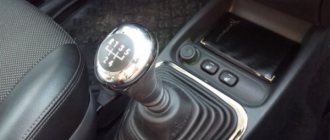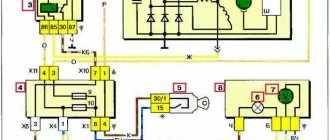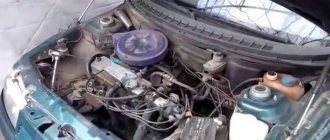Hi all! Any extraneous knocks or sounds when the car is operating should alert the driver. Regardless of the nature and origin, there should not be any unnecessary sounds during normal operation of the machine. Today I propose to talk about how the camshaft knocks, whether it can knock, why this happens and what to do in this situation.
The job of the camshaft or simply the camshaft is to control the opening and closing of the internal combustion engine valves. With its help, engine strokes are synchronized. As you know, valve knocking is also possible. We have already talked about them.
You should find out why such symptoms occur, what actions the car owner needs to take, and what consequences you should be prepared for if you do nothing.
A little about the camshaft
Fortunately for many, the camshaft is not one of the components that are positioned as capricious, often and quickly failing. The resource largely depends on the quality of the part and operating conditions.
The camshaft has a life limit. Uninterrupted operation can last from 50 to 150 thousand kilometers. These are fairly average indicators, since each situation is still individual. Active work is already underway to remove this element from the engine design. Moreover, experts say that in the future the camshaft may completely cease to be part of the engine. It will be replaced by electromagnetic actuators.
It is difficult to say how effective and realistic this will be in the near future. Plus, some skeptics doubt the correctness of the transition from a mechanical part to a computer-controlled actuator.
Elimination of lateral play
The lateral play is determined by loosening the camshaft up and down, for which one of the covers of the support cushions is removed. This play appears when the camshaft journals and the shaft bed support pads against which they rest are worn.
First, we dismantle both camshaft cushion covers and remove excess metal using an emery stone with a fine-grained abrasive. Its surface must be perfectly flat so as not to disturb the geometry of the part. An alternative is fine-grained sandpaper glued to smooth glass.
Can the camshaft make a knocking noise?
Many people have encountered crankshaft knocking in their lifetime. But not all drivers know how and when exactly the camshaft knocks.
It's all about the sounds. They are really very similar to each other. This appears the same on different cars:
- for VAZ 2106;
- Niva has 8 valves;
- VAZ 2107;
- VAZ 2109;
- on Priora;
- VAZ 2110;
- VAZ 2114;
- for Daewoo Nexia;
- for Subaru Forester, etc.
But what should a car owner do when he hears a sound, but cannot understand what exactly is knocking? Is it the crankshaft or the camshaft?!
Here you just need to listen and observe the behavior of the car and specifically the engine. Sometimes this makes it quickly clear where the source of extraneous sound is, and which unit needs to be prepared for repair.
The key role is played by the fact whether you hear sounds when it is cold or when it is hot.
You will be able to hear sounds from the camshaft only when the internal combustion engine is cold, when the engine starts and the lubricant has had time to leave the rubbing elements. After starting, the oil will gradually lubricate them, causing the knocking noise to disappear.
- The camshaft makes so-called dull sounds;
- Noises appear precisely when the engine is cold, when the engine starts;
- Initially the crankshaft sounds similar;
- As it gains speed, the faulty crankshaft acquires a louder sound;
- In fact, the camshaft is dull and the crankshaft is sonorous;
- An increase in speed will help to accurately determine;
- If you still can’t identify it by sound, you will have to carry out diagnostics.
Based on these points, you will be able to independently diagnose the nature and source of the malfunction without any problems, and then begin the appropriate actions to eliminate them.
We make a washer.
For the material for the washer, I took a piece of galvanized sheet about 0.5mm thick and secured it to a piece of MDF panel with four self-tapping screws (so it wouldn’t fidget).
I drew 2 circles with a marker (inner diameter 25mm, outer 35mm) and hollowed out the inner diameter with a chisel.
I cut out the outer diameter with metal scissors, and I ended up with a curve like this, with the washer blank all covered in burrs:
I processed the inner diameter of the washer with a round file, and sharpened the sharp corners on the outer one:
Install the washer.
We put the washer on the camshaft (it should fit freely, if not, then adjust the dimensions).
I entered freely:
Put the cover back and tighten it.
Attention! Be sure to check if the camshaft is jammed.
To do this, take a key set to 17 and try to rotate the camshaft.
It should turn with the same force as before installing the washer.
If the camshaft becomes very difficult to turn, or is completely jammed, then remove the cover again, take out the washer and grind it to thickness:
What to do
Drivers had to deal with the fact that occasionally after the start an incomprehensible knocking sound began to appear, but when accelerating and warming up the engine it disappeared. As we have already figured out, most likely the camshaft on the engine has failed.
Now another question. What to do in such a situation? If it is the camshaft that starts knocking, you should be prepared to spend a considerable amount of money. But this is not a 100% probability, since sometimes hydraulic compensators begin to knock, or knocking noises are made by worn gears and bearings. Not all situations solve the problem by replacing the entire camshaft. If you suspect a knocking noise from this unit, it is better to immediately go for diagnostics. Due diligence can help you find out where the source of the problem is and what needs to be done about it.
It’s definitely not worth delaying diagnostics. If the compensators fail, and the problem was in them, then the chain reaction will lead to the breakdown of the shaft itself. And these are completely different expenses. So it would definitely be a good idea to check the hydraulic compensators.
You can drive a car without hydraulic compensators with a knock from the camshaft for more than 50 thousand km, but then you will probably have to completely change the engine or carry out major repairs.
As you can see, delaying the check is definitely not in your interests.
Eliminating camshaft knock on an 8 valve engine
Before starting work, you need to remove the engine valve cover, remove the cover of the right support cushion and pull out the valve tappets. This will free up access to the camshaft and, if necessary, allow it to be rotated to determine the play, since the shaft is completely unloaded.
When the camshaft of a VAZ-2114 or another model from this series knocks, two types of play are observed - longitudinal and transverse, and each of them has its own method of elimination.
Elimination of longitudinal play
With longitudinal or axial play, a gap appears between the rear support cover and the camshaft flange. To eliminate this gap, you need to select a sealing washer. For this purpose, galvanization with a thickness of 0.5 mm is suitable, from which a washer with an internal diameter of 25 mm and an external diameter of 35 mm is cut.
Experience shows that this is enough to eliminate the camshaft axial play. Another option is a boot from bearing 302, which is installed on the car’s generator, so it’s better not to throw them away when replacing them. After removing the boot, you need to burn it to get rid of the rubber shell. The result is a metal washer that is ideal in size.
After this, remove the rear support cover, for which you need to unscrew 2 nuts and one bolt with a 10mm wrench. The washer is installed and the cover is put back in place. It is important that after tightening the shaft rotates freely; the force may increase slightly due to the elimination of backlash, but not critically. If the camshaft is tightly clamped and rotates with great effort or does not rotate at all, you need to remove the cover again and grind the washer. It happens that installing one washer does not remove the backlash; in this case, you need to install one or two more washers.
Spikes or Velcro, which is better in winter: reviews, tests, comparison
- Play in the shaft bed. It is unlikely that you will be able to solve the problem on your own. This requires boring or honing of the bed itself, or a complete replacement of the unit;
- Problems in the lubrication system. Even with a slight disruption of its operation, sound may appear. Moreover, the reason is not only in the quantity, but also in the quality of the lubricant;
- Deformation and mechanical damage. Most often, the supports burst and the neck breaks;
- Violations in the regulation of fuel supply processes;
- Development of the resource of cams. If the problem is definitely in the camshaft, and the knocking noise appears even when it’s hot, then the problem is in the cams.
It is almost impossible to give an accurate forecast as to what exactly was the source of the knocking noises without conducting comprehensive diagnostics. Masters often talk about this in various videos where the problem under consideration is described.
In any case, the knock should alert you. Whether you have hydraulic compensators or not, it does not matter. The sooner you send your car for diagnostics, the higher the chances of getting by with little damage and spending a minimum of effort and money to fix the problem. All in your hands.
Subscribe to our website, leave comments, ask relevant questions and tell your friends about our project!
How to determine valve knocking in a VAZ 2114 engine
The power plant of the VAZ 2114 is an internal combustion engine consisting of two main parts - the cylinder block and the cylinder head, which are a protective housing for the main working units. The camshaft, valves, piston group, cylinders and crankshaft rotate the flywheel, which in turn drives the vehicle's transmission. And all this, when the engine is running, rotates and moves in a forward-return rhythm with enormous frequency, under conditions of vibration and high temperature. The stress on every metal part of this automobile unit is incredibly high, so it is not surprising that parts wear out and sometimes make themselves known through abnormal operation or loud sounds.
Why is the engine knocking?
Among car enthusiasts who are quite far from professional knowledge of the design and physical essence of the operation of automobile units, but due to long-term driving practice, who consider themselves to be great experts on automobile “guts,” there is an opinion that if a knock appears in the engine, then it is the valves that are knocking. In reality, everything is not so simple. One very experienced automobile mechanic told a case that can serve as a clear illustration of incompetence and disrespect for the opinion of a professional.
“A car arrived at the workshop, the owner asked to adjust the valves. When we started the car for diagnostics, a characteristic knocking sound of the connecting rod in the crankshaft was revealed. This is a clear and unambiguous signal for immediate overhaul; there was no question of any valve adjustment; with such an engine it was impossible to even move away. The owner said that all friends and acquaintances and simply knowledgeable people unanimously affirm that this is the knocking of the valves. I was offended by the car mechanics and got into the car, but I couldn’t get far; a connecting rod broke and pierced the cylinder block. The engine had to be changed."
VAZ and GAZ specialists answer
VAZ and GAZ specialists answer
1. There is not a word in the VAZ 2110 service book that the injectors need to be washed periodically. However, the service center, referring to certain VAZ instructions, recommends doing this after 20–30 thousand km. Who to believe?
The factory instructions do not provide for cleaning the injectors. Similar work may be required if a decrease in fuel flow through the injectors is detected. The most likely reason for this is the use of low-quality gasoline.
2. Why, when adjusting the gaps on a VAZ 2110 engine, does the camshaft, after aligning the marks, still need to be turned in the same direction (clockwise) by about three teeth? Why don't they measure the clearance with the cam in a vertical position?
The text of the Repair Manual for the VAZ 2110 does not indicate the direction of turning, which is incorrect. It is desirable to turn it counterclockwise - in this case, the back of the cam of a constant radius is more reliably oriented towards the center of the adjusting washer compared to the position of the aligned marks. The step-by-step algorithm for adjusting valve clearances described in the Manual is designed for a person with minimal experience. In general, the valve clearance can be measured at any position of the camshaft, if the back of the cam with a constant radius is located opposite the center of the washer. The middle of the back of the cam is preferred, when its top is as far away from the washer as possible.
3. How to distinguish a timing cover with an antiphon from a regular one? Are these produced?
The cylinder head cover made of antiphon material is equipped with engines of 1.45 and 1.6 liters of “classic” cars equipped with an ECM, as well as 1.7-liter engines with an ECM on all-wheel drive VAZ 21214 and VAZ 2123. You can distinguish such a cover according to the following characteristics:
— a dull sound when tapping on the lid;
— when examining the edges of the cover from below, two layers of metal are visible, and the layer of plastic separating them is thin and practically invisible. In addition, engine covers VAZ 2104, 21067 and 2123 are distinguished by a threaded oil filler neck.
4. When repairing engines 2108, 2110, I more than once encountered axial play of the camshaft of 0.7 mm or even more. Does the plant regulate this value?
The tolerance for camshaft axial play for new engines of the 21081, 2108, 21083, 2110, 2111, 21114 family ranges from 0.15 to 0.53 mm. Since the interface “camshaft housing - camshaft - housing of auxiliary units”, which determines the axial clearance, wears out slightly, the repair documentation does not specify a maximum permissible value for it. Excessive play can be considered when an extraneous knock is heard, irregular but loud. Typically, the threshold for knocking is a play of 0.8–1.0 mm.
1. Should the release bearing rotate when the Volga engine is running?
Since 1979, Volga cars have been equipped with a backlash-free clutch release drive using a radial release bearing. This was done to reduce travel and pedal effort. When the engine is running, the release bearing, regardless of the position of the clutch pedal, rotates at the same speed as the crankshaft. This design is used on GAZ vehicles with ZMZ-402, 406, 405 engines.
How to change the rear oil seal
Changing the rear oil seal will be a little more difficult, but this does not mean that a car enthusiast cannot cope with such a task on his own. The most important thing is to follow the instructions, and every car enthusiast can do the job no worse than a professional:
- The negative terminal of the battery must be disconnected from the power supply.
- The flywheel is dismantled. Before removing the flywheel, you need to mark its original location, taking into account the location of the crankshaft.
- The rear clutch housing shield is removed from the bushings.
- The fasteners that secure the oil seal are unscrewed; there should be 8 fasteners.
- The holder is removed.
- Next, you need to carefully remove the seal that has become unusable from the holder.
- Using a mandrel with a diameter of 99 mm, the new oil seal must be pressed into place of the one just removed, making sure that the working edge of the element is directed inside the holder.
- You will definitely have to replace the holder gasket, even if the appearance of the old one seems quite normal.
- To ensure reliable installation of the gasket, it is recommended to use a thick consistency lubricant.
- Before installing the oil seal, its working surface should be treated with engine oil; the same procedure should be done with the crankshaft flange.
- It will be much easier to insert the holder of the working edge of the new oil seal onto the crankshaft flange using a wooden tool, for example, a stick of the appropriate size. But metal products are strictly not recommended for this event.
- After making sure that all elements are installed correctly, you can begin fixing the holder and engine crankcase.
- Next, the clutch housing protective shield, flywheel and gearbox are installed in their original place.
Video on the topic:
Camshaft play in the VAZ 2110 is one of the most common problems. If the camshaft play of the VAZ 21102 deviates from the norm, a specific knocking sound appears in the engine. This breakdown can significantly affect the normal operation of the engine. If the slightest unusual sounds appear in the engine, you must immediately check its correct functioning. Before contacting a service station, you can independently confirm your guesses. To do this, it is necessary to perform specific audio diagnostics. To do this, you may need a stethoscope.
Determination of DF failure
If it breaks down, slight difficulties arise with idle stability; when starting to move, a trimming effect is likely, as well as increased fuel consumption. These symptoms are associated with failure to receive data from the on-board driver about the ignition angle at a certain moment in engine operation. If there is no signal from the sensor, the control unit enters emergency mode, in other words, it starts working on a pre-programmed program without a sensor and generates an emergency error “0340” or “0343”.
Source
Reasons for replacement
The main reason for replacement is oil leakage. But here it is necessary to make one clarification. If oil streaks are visible on the front of the engine crankcase, this does not mean that the oil seal is faulty. First of all, the car owner should make sure that the crankcase ventilation system is working properly. If it (or the hoses) is clogged with dirt, then it is too early to change the oil seal. If the ventilation is in order, but oil still flows, the reason is definitely in the oil seal, and it needs to be changed urgently.
Replacing the front oil seal
It is recommended to replace the front oil seal yourself in the following sequence:
- use a screwdriver to remove the oil pump;
- remove the worn oil seal from the cover of the removed pump using a screwdriver;
- By resorting to the frame, a new part is installed in place of the worn one. The outer size of the new element should not exceed 41 mm; during installation, the working edge should be directed inside the pump;
- After making sure that the oil seal is well pressed, the oil pump is installed in its original place.
At this stage, the process of replacing the front valve that has become unusable is completed.
